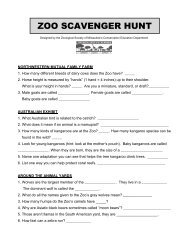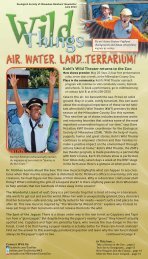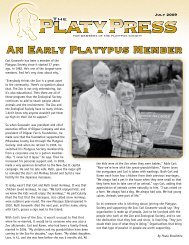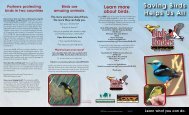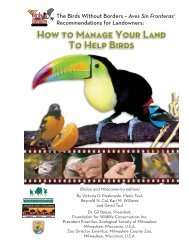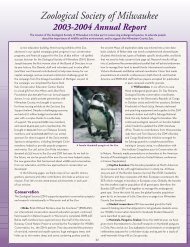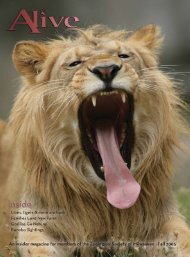Bonobo - Zoological Society of Milwaukee
Bonobo - Zoological Society of Milwaukee
Bonobo - Zoological Society of Milwaukee
You also want an ePaper? Increase the reach of your titles
YUMPU automatically turns print PDFs into web optimized ePapers that Google loves.
Conservation<br />
Chronicles<br />
Collazo feeds a<br />
moose at the Zoo.<br />
He can get this close<br />
only because this<br />
moose was handraised.<br />
He warns<br />
people never to<br />
approach or feed<br />
moose in the wild.<br />
Going Beyond the Job<br />
Some parents record baby’s height, weight and important<br />
milestones in a diary. Zookeeper Bob Collazo does the same for<br />
animals at the <strong>Milwaukee</strong> County Zoo. Flipping through dozens<br />
<strong>of</strong> notebooks filled with neat, hand-written notes and elaborate<br />
drawings, Collazo can tell you everything from Javier the tapir’s<br />
birth weight to the grizzly bear cubs’ size at age 1.<br />
In fact, Collazo has tracked the weight, height, length, growth<br />
and pregnancy patterns <strong>of</strong> animals under his care for years. He<br />
fills out journals and organizes notes on his own time, outside his<br />
day job as a zookeeper in Winter Quarters (the indoor area where<br />
many warm-weather animals spend the winter).<br />
Why does he do this extra work? Little is known about some<br />
zoo animals, says Collazo, and keepers can resort to guesses and<br />
assumptions. That’s a problem if they need to determine what’s<br />
“normal” or not for a species. For example, it helps to know how<br />
much weight an endangered Baird’s tapir gains and loses during<br />
pregnancy so keepers can adjust her diet. When Eve, one <strong>of</strong><br />
the Zoo’s Baird’s tapirs, was pregnant, Collazo weighed and<br />
photographed her weekly.<br />
Collazo has a special affinity for animal youngsters.<br />
He weighed all the kudu and tapir babies born at the Zoo since<br />
2004-2005. He tracked the weight, length, height and paw size<br />
<strong>of</strong> the Zoo’s three grizzly cubs (Brian, Bozeman, Chinook) when<br />
they were born here in 2002 to Mom Ronnie. He trained Furlow,<br />
a camel born at the Zoo in February 2010, to walk from one enclosure<br />
to another and to stand on a scale for regular weigh-ins. The<br />
training is done with positive reinforcements such as favorite food<br />
items, tender touch and verbal praise. That allows animals to trust<br />
the keepers. Even though Collazo in 2007 suffered a broken leg<br />
when he was kicked by a camel, he also trusts the animals, knowing<br />
that they don’t lash out unless they’re scared. When Furlow<br />
needed to be transferred to another zoo for breeding last<br />
November, Furlow’s trust allowed Collazo to lead the camel into<br />
a horse trailer solely with positive reinforcement, the first time<br />
a camel at our Zoo has done that.<br />
Collazo also works with older animals. For years, he and fellow<br />
keeper Mike H<strong>of</strong>fmann would measure the antlers <strong>of</strong> the Zoo’s<br />
10 Alive Spring-Summer 2011<br />
Bob Collazo trains a Baird’s tapir.<br />
late, great moose, Clifford, who died<br />
in 2010. Male moose shed and grow<br />
a new set <strong>of</strong> antlers every year, says<br />
Collazo, and he wanted to track<br />
how they change over time.<br />
The longest set was 26 inches.<br />
(See Collazo’s drawing <strong>of</strong> one<br />
set <strong>of</strong> antlers at right.)<br />
Collazo got into research and<br />
record-keeping when he began his career in the Zoo’s<br />
horticulture and grounds department. He noticed that staff<br />
would trim plants in animal exhibits and toss the cuttings; so<br />
he researched what plants could be given to animals to expand<br />
their diets. Thanks to his work – and with approval from Zoo<br />
veterinarians – the Zoo added weeping figs, ficus and Indiana<br />
clover to the menu. Collazo also helped to expand the Association<br />
<strong>of</strong> Zoo Horticulturalists’ list <strong>of</strong> plants safe for animal consumption.<br />
Today, Collazo juggles a half-dozen projects in addition to<br />
his zookeeping duties. He created enrichment activities such as<br />
adding new scents to the grizzly exhibit to keep the bears curious<br />
and active. He helps Dr. John Scheels, the Zoo’s consulting dentist<br />
who treats Zoo animals, by assisting during procedures and taping<br />
them for the video library in the Zoo’s Animal Health Center. And<br />
he develops new ways <strong>of</strong> enhancing animals’ lives, such as equine<br />
(horse) massage for tapirs and camels. Massage makes them<br />
tractable and helps calm them, he says.<br />
Collazo, who worked as a veterinary assistant before coming<br />
to the Zoo, grew up watching conservationists Marlin Perkins and<br />
Jacques Cousteau on TV. He admired their talent, but learned that<br />
“regular people” like him could care for animals if they were trained<br />
and devoted. Deputy Zoo Director Bruce Beehler praised Collazo’s<br />
devotion to animals. “Robert Collazo’s dedication to and initiatives<br />
in animal enrichment, training and comprehensive record-keeping<br />
are great examples <strong>of</strong> the work being done to enhance the lives <strong>of</strong><br />
animals at the Zoo.”<br />
By Julia Kolker



